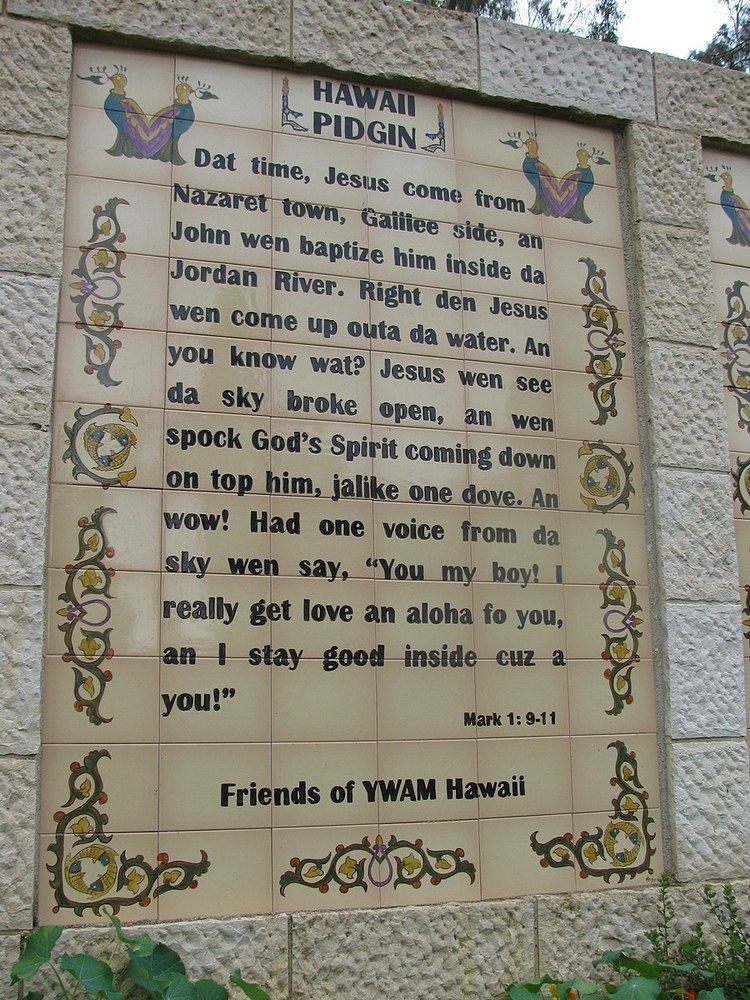ISO 639-3 hwc Linguasphere 52-ABB-dc | Native speakers 600,000 (2012) Glottolog hawa1247 | |
 | ||
Language family English CreolePacificHawaiian Creole English | ||
Hawaiian Pidgin English, Hawaiian Creole English, HCE, or locally known as simply Pidgin, is a creole language based in part on English, spoken by many residents of Hawaii. Although English and Hawaiian are the co-official languages of the state of Hawaii, Hawaiian Pidgin is used by many Hawaii residents in everyday casual conversation and is often used in advertising targeted toward locals in Hawaii. In the Hawaiian language, Hawaiian Creole English is called "ʻōlelo paʻi ʻai", which literally means "pounding-taro language".
Contents
Despite its name, Hawaiian Pidgin is not a pidgin, but rather a full-fledged, nativized, and demographically stable natural language. It did, however, evolve from various real pidgins spoken between ethnic groups in Hawaii.
History
Hawaiian Pidgin originated on sugarcane plantations as a form of communication used between English speaking residents and non-English speaking Native Hawaiians and foreign immigrants. It supplanted, and was influenced by, the existing pidgin that Native Hawaiians already used on plantations and elsewhere in Hawaii. Because such sugarcane plantations often hired workers from many different countries, a common language was needed in order for the plantation workers to communicate effectively with each other and their supervisors. Hawaiian Pidgin has been influenced by many different languages, including Portuguese, Hawaiian, American English, and Cantonese. As people of other language backgrounds were brought in to work on the plantations, such as Japanese, Filipinos, and Koreans, Hawaiian Pidgin acquired words from these languages. Japanese loanwords in Hawaii lists some of those words originally from Japanese. It has also been influenced to a lesser degree by Spanish spoken by Puerto Rican settlers in Hawaii. Hawaiian Pidgin was created mainly as a means of communication or to facilitate cooperation between the immigrants and the Americans to get business done. Even today, Hawaiian Pidgin retains some influences from these languages. For example, the word "stay" in Hawaiian Pidgin has a form and use similar to the Hawaiian verb "noho", Portuguese verb "ficar" or Spanish "estar", which mean "to be" but are used only when referring to a temporary state or location.
In the 19th and 20th centuries, Hawaiian Pidgin started to be used outside the plantation between ethnic groups. Public school children learned Hawaiian Pidgin from their classmates and parents. Living in a community mixed with various cultures led to the daily usage of Hawaiian Pidgin, also causing the language to expand. Children growing up with this language expanded Hawaiian Pidgin as their first language, or mother tongue. For this reason, linguists generally consider Hawaiian Pidgin to be a creole language.
Phonology
Hawaiian Pidgin has distinct pronunciation differences from standard American English (SAE). Some key differences include the following:
Grammatical features
Hawaiian Pidgin also has distinct grammatical forms not found in SAE, but some of which are shared with other dialectal forms of English or may derive from other linguistic influences.
Forms used for SAE "to be":
Note that these constructions also mimic the grammar of the Hawaiian language. In Hawaiian, "nani ka pēpē" or "kiuke ka pēpē" is literally "cute, the baby" and is perfectly correct Hawaiian grammar meaning in English, "The baby is cute."
For tense-marking of verb, auxiliary verbs are employed:
Sociolinguistics
The language is highly stigmatized in formal settings.
Many tourists find Hawaiian Pidgin appealing. Local travel companies favor those who speak Hawaiian Pidgin and hire them as speakers or customer service agents.
Literature and performing arts
In recent years, writers from Hawaii such as Lois-Ann Yamanaka, Joe Balaz and Lee Tonouchi have written poems, short stories, and other works in Hawaiian Pidgin. A Hawaiian Pidgin translation of the New Testament (called Da Jesus Book) has also been created, as has an adaptation of William Shakespeare's Twelfth Night, or What You Will, titled in Hawaiian Pidgin "twelf nite o' WATEVA!"
Several theater companies in Hawaiʻi produce plays written and performed in Hawaiian Pidgin. The most notable of these companies is Kumu Kahua Theater.
Hawaiian Pidgin has occasionally been featured on Hawaii Five-0 as the protagonists frequently interact with locals. The show heavily features Hawaiian culture and is filmed on location.
Milton Murayama's novel All I asking for is my body uses Hawaii Pidgin in the title of the novel.
